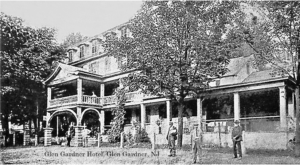My last post reviewed my pre-work performed before a census search. I created a research question or goal and arrived at a plan. The plan is generated by analyzing the target date and the records available for the time frame.
My research plan is to search the Federal Census, Militia Records, and New Jersey Tax Ratables for a man with the surname of Teeple, Deeple, and other variants who was born as late as 1765 and died after 1830, possibly as late as 1866. I begin with the 1830 census.
I start with FamilySearch, and I will double up with Ancestry records. This combination is my preference, yours may be different, but I do advise that you review two different sets; casting a wider net due to indexing variations. Family search does an excellent job of picking up variants, but more importantly, it permits the downloading of records to a spreadsheet, which means less data entry.
I log into FamilySearch (always do this first, accounts are free), and search records with my starting criteria:
- Surname – Teeple
- Residence Place – New Jersey
- Residence Year – 1830 to 1830
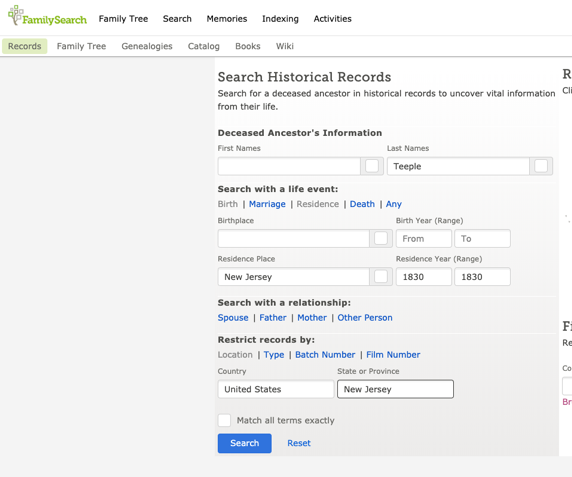
I will limit my records by date and location but not “Match all terms exactly;” I want to see variants, and I can adjust later.
I scan the results, but ultimately I am going to isolate the 1830 census, select the “Collections” tab, click on the “United States Census, 1830” box, and then “Filter these Results.”
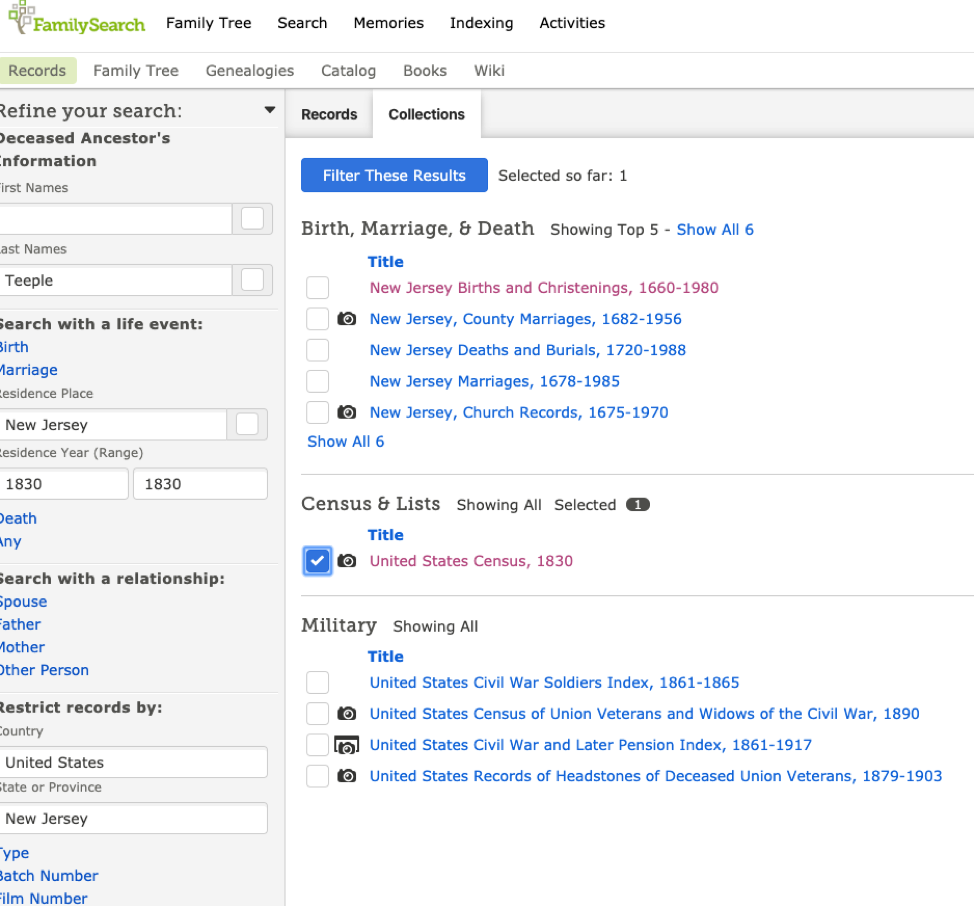
I switch back to the records tab and see what returns, depending on the scenario, further filtering may be needed. In this case, it is not, I am working with a relatively uncommon name, in an early period. There aren’t pages of entries. If there were, I would adjust the “Number of results to show” to 100. Using the “Export Results” option, I download the results into *.xls format, page by page. I would then eventually combine the files into a single workbook.
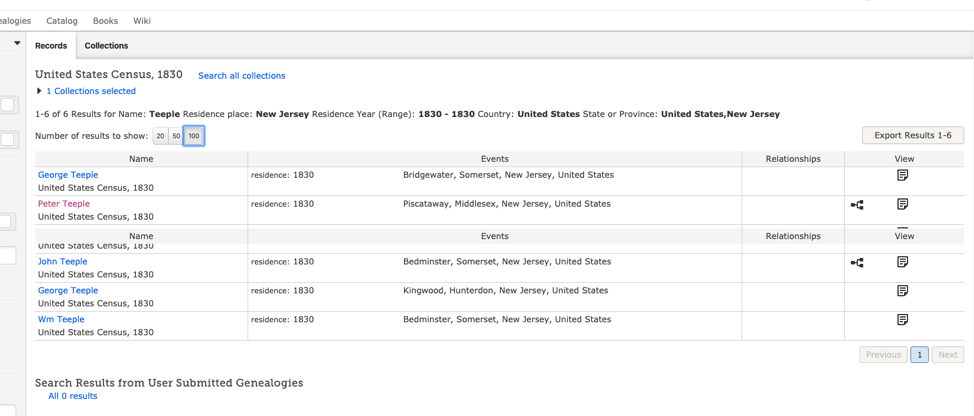
The downloaded raw data will look like this:

There’s not a ton of fields populated because the 1830 census didn’t have many data points, but you can see that the fields are in place, so if this were the 1880 census, more data would be downloaded.
Some excellent features offered by FamilySearch (besides being free!), is the “person url field.” Click on it, and it will pull up the image right from your spreadsheet. FamilySearch provides citations to copy and paste; I, however, create my own:
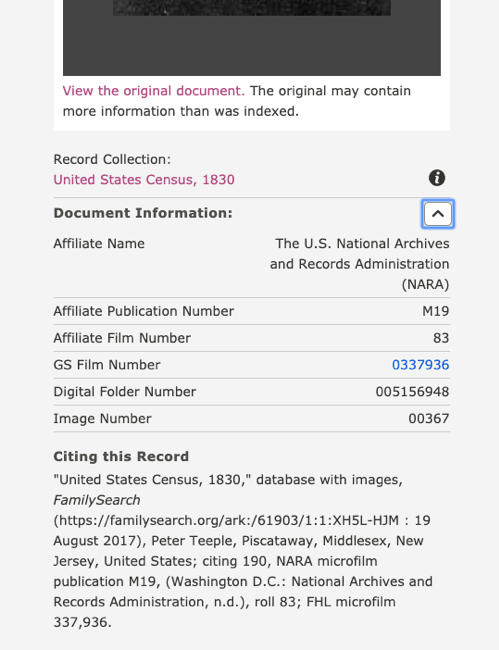
I copy the combined downloads into an excel template that I have prepared for the 1830 Census; this becomes the basis of my list. I perform the same query in Ancestry.com and print the result summary. I review a copy of each census image in Ancestry or FamilySearch manually, adding any households not picked up by FamilySearch. It’s not unusual to have different results in the two repositories, that’s the point of checking more than one set of an online census. I view each image to ensure that it’s not an indexing error, if there are neighboring connected families (such as Teeple, or Clauson in this scenario), and document the findings. The 1830 census does not have more than the head of the household named, As I view and cite each census image, I record the number of inhabitants just as they were enumerated. I also ensure that the indexing was accurate, sometimes F and T are confused. Once these steps are completed, I should have a solid list of those who were enumerated that match my criteria. However, I will also view an area line by line if I feel there is a gap.
The Analysis
Recalling the research goal:
Find a man with the surname of Teeple, Deeple, and other variants who was born as late as 1765. He could have been living in Warren County, New Jersey, or Warren Township, Somerset County, New Jersey. Remember that only the head of the household was named, who could, in theory, be any male over 21. In other words, we are looking for households that had a white male resident enumerated in the correct age group, keeping in mind that he may not have been the head of the household. Based on my research goals, I create a color-coded key to determine the “strength” of the match. In scenarios with vast
numbers of entries it helps me tame the list with filtering and pivot tables:

Following is the result of today’s exercise; it is a short list:
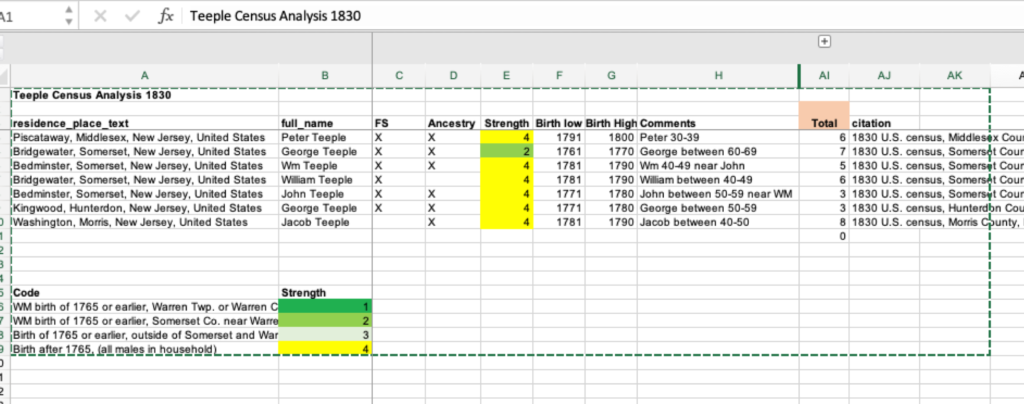
In this scenario, only one Teeple household enumerated in New Jersey on the federal population schedule of 1830 has a white male resident old enough to be the father of Peter Teeple.
In the 1830 census, there was only one household that matched our criteria for the father of Peter Teeple, George Teeple of Bridgewater, Somerset County New Jersey. Is this sufficient evidence to say George Teeple was the father of Peter Teeple? Not at all. Though, it is a building block. Remember, census records can have gaps, and misinformation. We relied on an interview with Peter’s son, George, who indicated that his grandfather was from Pluckemin and lived to 101. He never named his grandfather, and though he was speaking of his paternal line in the interview, it could have been his maternal grandfather as well. The 1830 census analysis is just the start of the journey; more work is needed. George Teeple was the only adult male of the household, and there were no other Teeple households with a man of that age. But what if Peter’s father was living with a married daughter?
My
next step will be to utilize a census substitute and go back in time, closer to
the birth date of Peter Teeple.
[i] FamilySearch (http://familysearch.org : accessed 15 March 2020), “Search Historical Records.”
[ii] FamilySearch (http://familysearch.org : accessed 15 March 2020), “Filter These Results.”
[iii] FamilySearch (http://familysearch.org : accessed 15 March 2020), “1830 Census Search results.”
Figure 6:
1830 U.S. census, Middlesex County, New Jersey, population schedule, Piscataway, sheet 190 (written), Peter Teeple; digital image, Ancestry.com, (http://www.ancestry.com : accessed 14 December 2018), citing National Archives microfilm publication M19, Roll 83.
1830 U.S. census, Somerset County, New Jersey, population schedule, Bridgewater, page 60 (written), George Teeple; digital image, Ancestry.com, (http://www.ancestry.com : accessed 1 March 2020), citing National Archives microfilm publication M19, Roll 83.
1830 U.S. census, Somerset County, New Jersey, population schedule, Bedminster, page 75 (written), Wm {William] Teeple; digital image, Ancestry.com, (http://www.ancestry.com : accessed 1 March 2020), citing National Archives microfilm publication M19, Roll 83.
1830 U.S. census, Somerset County, New Jersey, population schedule, Bridgewater, page 55 (written), William Teeple; digital image, Ancestry.com, (http://www.ancestry.com : accessed 1 March 2020), citing National Archives microfilm publication M19, Roll 83.
1830 U.S. census, Somerset County, New Jersey, population schedule, Bedminster, page 75 (written), John Teeple; digital image, Ancestry.com, (http://www.ancestry.com : accessed 1 March 2020), citing National Archives microfilm publication M19, Roll 83.
1830 U.S. census, Hunterdon County, New Jersey, population schedule, Kingwood, page 378 (written), George Teeple; digital image, Ancestry.com, (http://www.ancestry.com : accessed 1 March 2020), citing National Archives microfilm publication M19, Roll 83.
1830 U.S. census, Morris County, New Jersey, population schedule, Washington, page 82 (written), Jacob Teeple; digital image, Ancestry.com, (http://www.ancestry.com : accessed 1 March 2020), citing National Archives microfilm publication M19, Roll 82.



